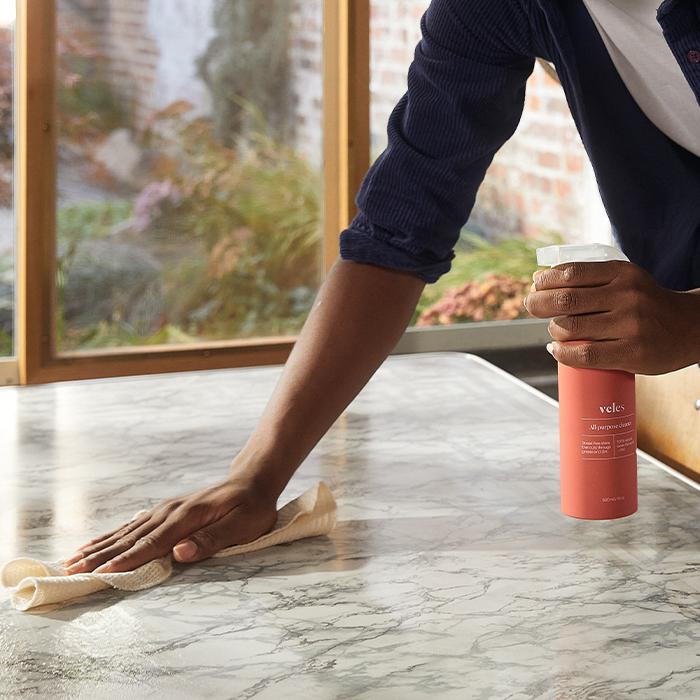When you open up your cabinet and grab your bottle of household cleaning spray, you’re likely to find a long list of chemicals on the label that promise to wipe away germs and mess.
But as it turns out the most common ingredient in the cleaner isn’t any given chemical, it’s a component that can be found in the nearly 1.3 billion tons of food that’s wasted each and every year: water. For the team behind Veles, the world’s first closed-loop household cleaning spray made from food waste, it’s that shared component that’s crucial to fueling a sustainable product revolution.
The closed-loop cleaner
Veles is the first consumer product from Ambrosia, a food waste solutions company based in New York. Named after a mythical god of earth and water, the product is made almost exclusively from food waste—97% to be exact. The other 3% consists of essential oils for scent (hints of lavender, peppermint and bergamot) and stabilizer.
But how does food waste become a household cleaner? Simply put, science. Using a process developed over the last six years, Veles separates the water from the food waste and purifies it, while the food waste itself is used to derive the other active ingredients.
“We generate organic acids and alcohols [by] fermenting food waste,” Ambrosia co-founder and Veles CEO Amanda Weeks told us. The result is a product with a short ingredient list: acetic acid, lactic acid, alcohol, water, fragrance and stabilizer.
Veles’ commitment to sustainability doesn’t end in the cleaner’s active ingredients. Everything from packaging to distribution to marketing was designed to have the smallest environmental footprint possible.
“We really were trying to validate every single choice that we were making as well as seek out the best partners and the best packaging options to reduce plastic waste,” Weeks said. “Just navigating the world of packaging was really eye-opening in terms of how far that industry really has to go to be more sustainable.”
As a result, Veles is housed in an infinitely recyclable aluminum bottle, with larger refills available in glass containers. Both the aluminum spray bottle and glass refills are sourced from US-based overstock suppliers to reduce the amount of newly-minted packaging.

Sourcing the food waste has a positive impact on the environment, too. By working directly with waste haulers in the New York area, Ambrosia reduces the amount of food waste that decomposes in landfills and generates greenhouse gas emissions.
All told, one simple bottle of cleaning spray makes a big environmental impact.
Challenges along the way
The journey to launching Veles wasn’t an easy one. Amanda Weeks and the team at Ambrosia faced an uphill climb—in terms of securing funding and production.
Prior to beginning work on the cleaning product that would become Veles in 2017, Ambrosia focused on managing and recycling food waste in limited spaces without odor.
“Our business model was foreign to many of the investors we spoke with in New York City,” Weeks told us of her early meetings. “A lot of our early pitches were me spending an hour explaining the waste industry to investors.”
Between a lack of knowledge in the waste and sustainability sectors and a narrow focus on technology or other verticals, many venture capital firms passed during early fundraising in 2014-15. But as the company continued to work on its bio-refinement process, it began exploring product opportunities that would be impactful and interesting to investors and consumers alike.
Thus the idea for a household cleaner made from food waste was born.
As the funding rolled in, perfecting the product proved challenging as well. In order to get all the ingredients to work together, Veles needed a stabilizing agent. But nearly all stabilizers found in household cleaners are made from synthetic chemicals. So the team took matters into their own hands and developed their own plant-based stabilizer to keep the product 100% natural.
There was also the matter of finding the right mix of partners to ensure their product was as sustainable as possible. “From packaging to our collection of vendors to how we ship the product to where it’s stored, all the choices we made to decrease the overall footprint of the product was one of the things that extended our timeline to launch by so much,” Weeks said, emphasizing how crucial it was to their mission.
And it's that commitment to being sustainable and transparent that’s paid off, with more than 1,000 bottles sold directly to consumers in the first 10 weeks of their February launch.
On the horizon
So what’s next for Veles and Ambrosia? Production and shipping of Veles is steady, even as Ambrosia’s research and development efforts slow due to COVID-19. But Weeks remains optimistic.
“I think in the future Ambrosia will be operating multiple food-based recycling facilities across the country and will continue to develop different products,” she told us. In addition to scaling up production, partnerships with other brands and companies looking to leverage Ambrosia’s food waste expertise seemed likely as well.
“We’re really starting to make a change to the base of our consumption…reducing the use of natural resources and utilizing a waste material [for good].”
All assets courtesy of Veles.
